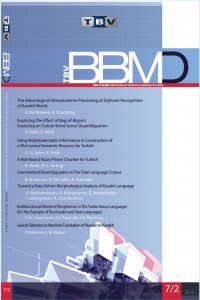Öz
Kaynakça
- [1] SULEYMANOV, D.SH., GATIATULLIN, A.R. Strukturno-funktsionalnaya kompyuternaya model tatarskikh morfem [Structural-functional computer model of the Tatar morphemes]. Kazan: FEN, 2003. 220 p. (rus)
- [2] SULEYMANOV, D.SH., GATIATULLIN, A.R. Napolneniye semanticheskikh slotov relyatsionno-situatsionnogo freyma na primere tatarskikh sintaksem [Filling of semantic slots of the relational-situational frame on the example of the Tatar syntaxemes] // Collection of works of the conference “Open semantic technologies of designing intelligent systems” (OSTIS-2014). Minsk: BSUIR, 2014. P. 178. (rus)
MULTIFUNCTIONAL MODEL OF MORPHEMES IN THE TURKIC GROUP LANGUAGES (ON THE EXAMPLE OF THE KAZAKH AND TATAR LANGUAGES)
Öz
This article describes a multifunctional computer model of the Turkic affixal morphemes. This model is a hierarchical system of characteristics of morphemes belonging to different language levels: phonological, morphological, syntactic and semantic, and it requires a certain structure and unification in the description of characteristics of morphemes. It is a kind of “inventory” base of the language that can be used for different purposes; in particular, to perform automated comparative analysis of the properties of the Turkic languages, and to develop different linguoprocessors working with Turkic languages. Here, we describe the elements of the multifunctional computer model with examples on the Tatar and Kazakh languages.
Anahtar Kelimeler
multifunctional model affixal morpheme Tatar language Kazakh language
Kaynakça
- [1] SULEYMANOV, D.SH., GATIATULLIN, A.R. Strukturno-funktsionalnaya kompyuternaya model tatarskikh morfem [Structural-functional computer model of the Tatar morphemes]. Kazan: FEN, 2003. 220 p. (rus)
- [2] SULEYMANOV, D.SH., GATIATULLIN, A.R. Napolneniye semanticheskikh slotov relyatsionno-situatsionnogo freyma na primere tatarskikh sintaksem [Filling of semantic slots of the relational-situational frame on the example of the Tatar syntaxemes] // Collection of works of the conference “Open semantic technologies of designing intelligent systems” (OSTIS-2014). Minsk: BSUIR, 2014. P. 178. (rus)
Ayrıntılar
| Diğer ID | JA37MP86ST |
|---|---|
| Bölüm | Makaleler(Araştırma) |
| Yazarlar | |
| Yayımlanma Tarihi | 21 Aralık 2014 |
| Yayımlandığı Sayı | Yıl 2014 Cilt: 7 Sayı: 2 |
Kaynak Göster
https://i.creativecommons.org/l/by-nc/4.0Makale Kabulü | |
Çevrimiçi makale yüklemesi yapmak için kullanıcı kayıt/girişini kullanınız. Dergiye gönderilen makalelerin kabul süreci şu aşamalardan oluşmaktadır: 1. Gönderilen her makale ilk aşamada en az iki hakeme gönderilmektedir. 2. Hakem ataması, dergi editörleri tarafından yapılmaktadır. Derginin hakem havuzunda yaklaşık 200 hakem bulunmaktadır ve bu hakemler ilgi alanlarına göre sınıflandırılmıştır. Her hakeme ilgilendiği konuda makale gönderilmektedir. Hakem seçimi menfaat çatışmasına neden olmayacak biçimde yapılmaktadır. 3. Hakemlere gönderilen makalelerde yazar adları kapatılmaktadır. 4. Hakemlere bir makalenin nasıl değerlendirileceği açıklanmaktadır ve aşağıda görülen değerlendirme formunu doldurmaları istenmektedir. 5. İki hakemin olumlu görüş bildirdiği makaleler editörler tarafından benzerlik incelemesinden geçirilir. Makalelerdeki benzerliğin %25’ten küçük olması beklenir. 6. Tüm aşamaları geçmiş olan bir bildiri dil ve sunuş açısından editör tarafından incelenir ve gerekli düzeltme ve iyileştirmeler yapılır. Gerekirse yazarlara durum bildirilir.
|



